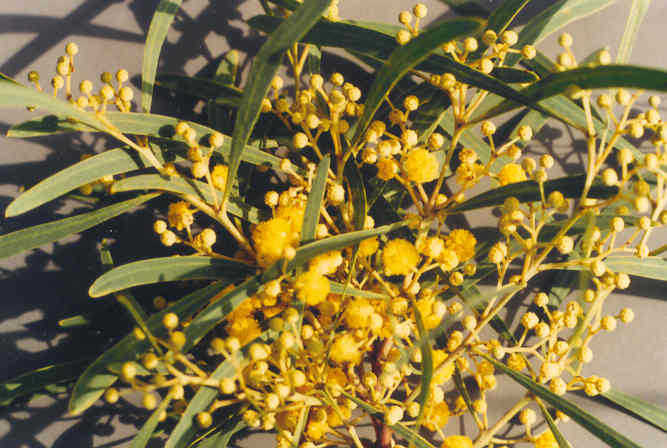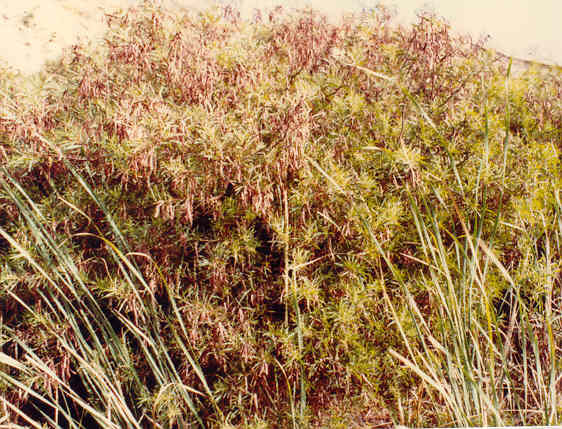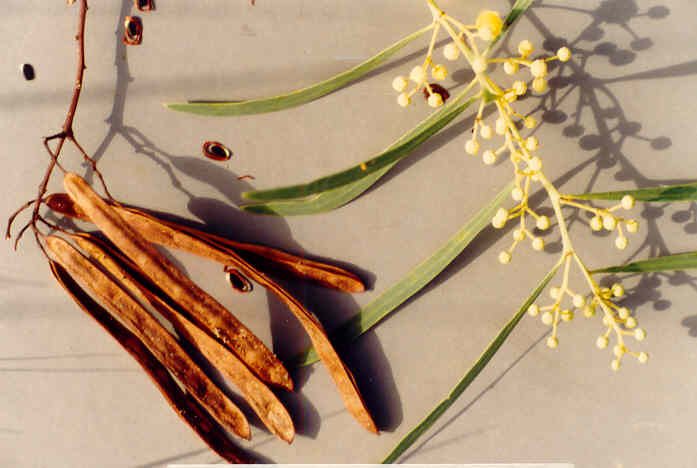
Acacia retinodes Schlecht.
 |
Acacia retinodes Schlecht.
Fabaceae (Pea Family)AustraliaWirildaEverblooming Acacia |
July Photo
Plant Characteristics:
Small unarmed, tree, 5-8 m. tall or +/- shrubby, with spreading branches
drooping at ends; twigs generally nerved; phyllodia one nerved, blue or
yellow-green, 8-15 cm. long, 0.6-1.8 cm. wide with a marginal gland 6-12 mm.
above the base; flowers pale
yellow, in globose heads on lateral racemes; legumes 7-10 cm. long, about 0.6
cm. wide, flat, generally straight, slightly narrowed between seeds, brown; seed
arilled; stalk encircling seed in a double fold.
Habitat:
Cult. Australian sp.; occasional escape.
Fls. much of the year.
Name:
Greek, akakie, from ake, a point, because of the prickles. (Munz, Calif. Flora
797). Latin, retin, a fine net and Greek, odes,
meaning a thing like. (Jaeger
171,219). I do not see the
relationship of the plant to the species name.
Possibly the species is close in appearance to some plant with a name
like retin, (my comment) or as
suggested by John Johnson, retin means
"resin of the pine" in Greek. Some
acacias put forth much resin or gum.
General:
Uncommon in the study area, an escape from cultivation.
The photographed specimen is located on Backbay Dr. between the Dunes and
San Joaquin Hills Rd. (my comments).
See A. cyanophylla for notes on
uses and history. An immense genus,
chiefly in subtropical regions, but especially in Africa and Australia.
Many species of horticultural value.
(Munz, Flora So. Calif. 421).
The powdered pods and leaves of A.
greggii make an excellent infused tea for diarrhea and dysentery, as well as
a strongly astringent hemostatic and antimicrobial wash.
The straight powder will stop superficial bleeding, and can also be
dusted into moist, chafed body folds and dusted on infants for diaper rash.
It was widely used by Native Americans for treating sore backs and flanks
of their horses. (Moore, Medicinal
Plants of the Desert and Canyon West. 12).
Text Ref:
Hickman, Ed. 582; Munz, Calif.
Flora 797; Munz, Flora So. Calif.
421; Roberts 23.
Photo Ref:
July 2 83 # 4,5,6.
Identity: by R. De Ruff,
confirmed by G. Marsh.
First Found: July 1983.
Computer Ref: Plant Data 73.
Have plant specimen.
Last edit 12/18/04
 |
 |
.